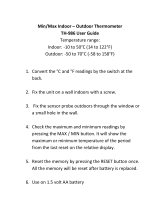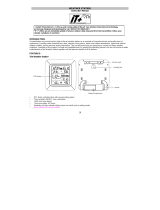
55
7. If after 10 minutes, the DCF time has not been received, press and hold the OK () key for 3
seconds to enter the Set up mode for manual time setting. The clock of the temperature station will
automatically attempt to receive the DCF time at midnight. When this is successful, the received
time will override the manually set time. The date is also updated with the received time. (Please
refer also to notes on “Radio controlled Time Reception” and “Manual Setting”).
DCF-77 RADIO CONTROLLED TIME
The time base for the radio controlled time is a Cesium Atomic Clock operated by the Physikalisch
Technische Bundesanstalt Braunschweig which has a time deviation of less than one second in one million
years. The time is coded and transmitted from Mainflingen near Frankfurt via frequency signal DCF-77
(77.5 kHz) and has a transmitting range of approximately 1,500 km. Your radio-controlled Temperature
Station receives this signal and converts it to show the precise time in summer or wintertime.
The quality of the reception depends greatly on the geographic location. In normal cases, there should be
no reception problems within a 1500km radius of Frankfurt.
Once the outdoor reception test period is completed, the DCF tower icon in the clock display will start
flashing in the upper center. This indicates that the clock has detected that there is a radio signal present
and is trying to receive it. When the time code is received, the DCF tower becomes permanently lit and the
time will be displayed.
If the tower icon flashes, but does not set the time or the DCF tower does not appear at all, then please
take note of the following:
•
Recommended distance to any interfering sources like computer monitors or TV sets is a minimum
of 1.5 - 2 meters.
•
Within ferro-concrete rooms (basements, superstructures), the received signal is naturally
weakened. In extreme cases, please place the unit close to a window and/ or point its front or back
towards the Frankfurt transmitter.
•
During nighttime, the atmospheric disturbances are usually less severe and reception is possible in
most cases. A single daily reception is adequate to keep the accuracy deviation below 1 second.

























